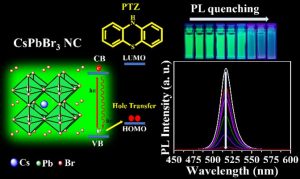 Dr Nimai Mishra, Assistant Professor, Department of Chemistry, SRM University-AP along with his team comprising of his PhD scholars Mr. Syed Akhil, Ms. V.G.Vasavi Dutt, and Mr Rahul Singh have published a research article titled “Surface-State-Mediated Interfacial Hole Transfer Dynamics Between CsPbBr3 Perovskite Nanocrystals and Phenothiazine Redox Couple” in The Journal of Physical Chemistry-C, published by The American Chemical Society with an impact factor of ~4.126.
Dr Nimai Mishra, Assistant Professor, Department of Chemistry, SRM University-AP along with his team comprising of his PhD scholars Mr. Syed Akhil, Ms. V.G.Vasavi Dutt, and Mr Rahul Singh have published a research article titled “Surface-State-Mediated Interfacial Hole Transfer Dynamics Between CsPbBr3 Perovskite Nanocrystals and Phenothiazine Redox Couple” in The Journal of Physical Chemistry-C, published by The American Chemical Society with an impact factor of ~4.126.
Dr Mishra’s research interests lie in Semiconductor nanocrystals, Core/shell branched structures, Nanowires, Perovskite nanocrystals and Optoelectronic device fabrication. He studied the role of surface chemistry for improving excited state hole transfer from CsPbBr3 nanocrystals to an acceptor, potentially applicable for photocatalytic applications.
About the research:
 Recently, caesium lead bromide (CsPbBr3) perovskite nanocrystals (PNCs) gained enormous attention for designing photocatalytic reactions because of their photocatalytic properties. But the surface chemistry of nanocrystals is often ignored which dictate the excited state interactions of these semiconductor nanocrystals with the charge shuttling redox-active molecules. In this work, we have explored the impact of CsPbBr3 perovskite nanocrystals with the three different surface chemistries on the excited state interactions with the standard hole acceptor phenothiazine molecule. From the steady PL-lifetime decay measurements we have calculated the photoinduced hole transfer (PHT). In the amine-free PNCs case, PHT is 6 times higher than the conventional amine capped ligands. Using the lifetime fast component (1) rate constants, we have calculated the hole transfer constant (kht) which is 3.942 × 108 s-1 and it is 4 times higher in amine-free ligands when compared with conventional amine ligands system.
Recently, caesium lead bromide (CsPbBr3) perovskite nanocrystals (PNCs) gained enormous attention for designing photocatalytic reactions because of their photocatalytic properties. But the surface chemistry of nanocrystals is often ignored which dictate the excited state interactions of these semiconductor nanocrystals with the charge shuttling redox-active molecules. In this work, we have explored the impact of CsPbBr3 perovskite nanocrystals with the three different surface chemistries on the excited state interactions with the standard hole acceptor phenothiazine molecule. From the steady PL-lifetime decay measurements we have calculated the photoinduced hole transfer (PHT). In the amine-free PNCs case, PHT is 6 times higher than the conventional amine capped ligands. Using the lifetime fast component (1) rate constants, we have calculated the hole transfer constant (kht) which is 3.942 × 108 s-1 and it is 4 times higher in amine-free ligands when compared with conventional amine ligands system.
According to Dr Nimai Mishra, the most important contribution of this research is that these results highlight the impact of surface chemistry on the excited state interactions of CsPbBr3 PNCs and conclude amine-free PNCs could be an ideal candidate for photocatalytic reactions.
Read the full paper: https://pubs.acs.org/doi/10.1021/acs.jpcc.1c07129

